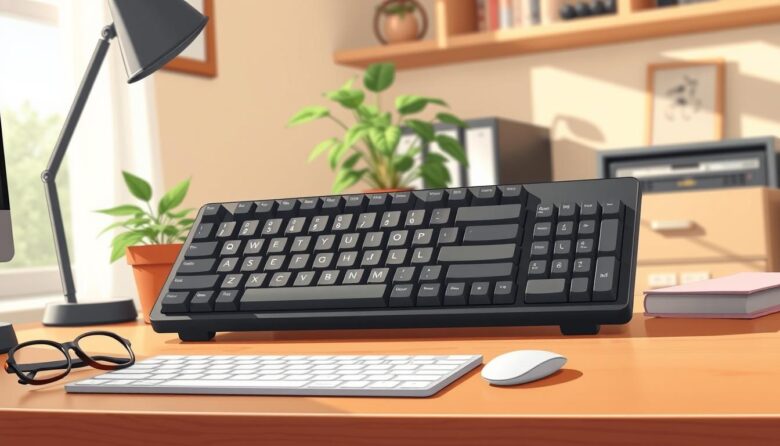Mastering digital communication starts with confidence at your fingertips. Whether you want to send emails, connect with family online, or manage daily tasks, building typing skills creates new opportunities. Modern tools make learning simpler than ever, with programs designed for comfort and gradual progress.
You might wonder why these abilities matter now. Nearly every part of daily life—from banking to shopping—relies on digital platforms. Efficient typing helps you navigate these tasks smoothly, saving time and reducing frustration. It’s not about speed; it’s about feeling empowered in today’s connected world.
Free resources like TypingClub offer interactive lessons used by millions. This web-based program uses games, badges, and posture guides to build muscle memory. No downloads are needed—just a browser and your device. With short daily sessions, you’ll see steady improvement without overwhelming effort.
Age is no barrier to learning. Many seniors discover that regular practice strengthens their skills naturally. The key lies in finding methods that feel enjoyable, not intimidating. Ready to start your journey? Let’s explore how small steps today can lead to lasting confidence tomorrow.
Key Takeaways
- Typing proficiency enhances daily digital tasks like emailing and online shopping
- Free programs like TypingClub use game-like lessons to simplify learning
- Proper hand positioning and short practice sessions yield better results
- Progress tracking features help maintain motivation and celebrate achievements
- Consistent practice matters more than natural talent or prior experience
Getting Started With Keyboard and Typing Basics
Discovering digital tools begins with knowing where your fingers belong. Most devices use the QWERTY layout, designed to help you reach letters efficiently. Let’s break down how this system works and which resources make learning stress-free.
Finding Your Way Around the Letters
Your left hand naturally rests on A, S, D, and F, while your right hand stays on J, K, L, and the semicolon. These home row markers keep your movements organized. Notice the tiny bumps on F and J—they’re your guides for proper finger placement without peeking.
Each digit manages specific areas. For example, your left middle finger handles E and C, while your index fingers tackle the central columns. This division reduces strain and helps you build accuracy over time.
Tools That Make Learning Enjoyable
Programs like TypingClub turn skill-building into a game. Their free lessons show real-time feedback with color-coded guides for each keystroke. You’ll see which fingers to use for every letter, making practice sessions both structured and engaging.
Short daily exercises work best. Focus on mastering a few letters at a time before expanding your reach. Many learners find tracking their progress through badges and speed tests keeps motivation high. Remember, steady effort beats rushing through drills.
Building Pressure-Free Typing Habits
Creating comfortable routines transforms how you interact with technology. Modern devices respond to feather-light touches, letting your fingers glide rather than pound. This approach reduces physical strain while helping you work smarter.
Finding the Right Touch and Posture
Your hands should hover slightly above the keys like a pianist ready to play. Gentle taps activate letters without jabbing motions. Notice how your wrists stay straight, not bent upward or downward.
Proper alignment starts from your chair. Sit with feet flat and screen at eye level to avoid neck strain. Shoulders relax as elbows form a 90-degree angle. This setup lets your arms support finger movements naturally.
Using Minimal Key Pressure for Efficiency
Think of each keystroke as brushing a piano key, not striking a typewriter. Most modern keys register with just 45 grams of force—lighter than pressing a TV remote button. Lighter touches mean faster transitions between letters.
Start with 5-minute sessions focusing on one row of keys. Gradually increase time as your muscles adapt. If your hands feel stiff, shake them out and reset your posture. Consistent practice builds fluid motion better than marathon sessions.
Mastering Home Row Techniques and Finger Positioning
Building lasting skills begins with understanding your hands’ natural resting spots. The home row serves as your command center, with your left hand covering A, S, D, F and your right hand on J, K, L, and semicolon. This foundation keeps your movements organized and efficient.
Locating the Home Row Keys
Rest your thumbs lightly below the space bar—use whichever feels natural for spacing. Your pinkies manage Shift keys for capitals while staying anchored to their home positions. The tiny bumps on F and J help relocate your index fingers without looking down.
Each finger handles specific letters extending from the home base. Your middle fingers reach upward for E and C, while ring fingers tackle W and X. This division of labor reduces strain and builds precision over time.
Enhancing Muscle Memory Through Targeted Practice
Start with simple exercises repeating “asdf jkl;” to strengthen position awareness. Gradually mix in letters like G and H, controlled by your index fingers. Focus on accuracy first—speed follows naturally as muscle memory develops.
Try 10-minute sessions typing common words using home row letters. Programs like TypingClub offer drills that highlight proper finger movements in real time. Celebrate small wins—consistent effort creates lasting progress.
Wrapping Up Your Typing Journey
Your progress with digital communication deserves celebration. Through focused practice and smart tool selection, you’ve built skills that simplify daily tasks. Remember—consistency matters more than marathon sessions. Even five minutes daily maintains muscle memory.
Platforms like TypingClub offer free typing challenges to keep learning fresh. Explore story-based drills in Spanish or French, or test different layouts like Dvorak. These variations sharpen accuracy while preventing boredom.
Track your growing confidence through real-world wins. Crafting emails without hunting for letters or posting on social media with 100 accuracy shows tangible progress. Notice how your hands now find the home row naturally—proof of developing muscle memory.
Stay curious about new resources. Interactive games and adaptive courses keep lessons engaging. With your foundation set, you’re ready to explore specialized programs for unique needs or creative projects. Every keystroke now connects you more deeply to our digital world.



